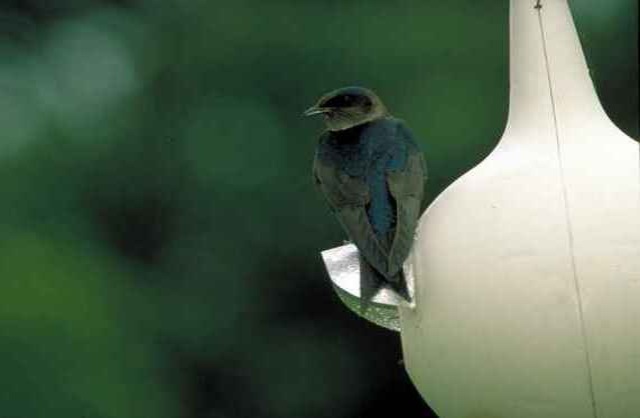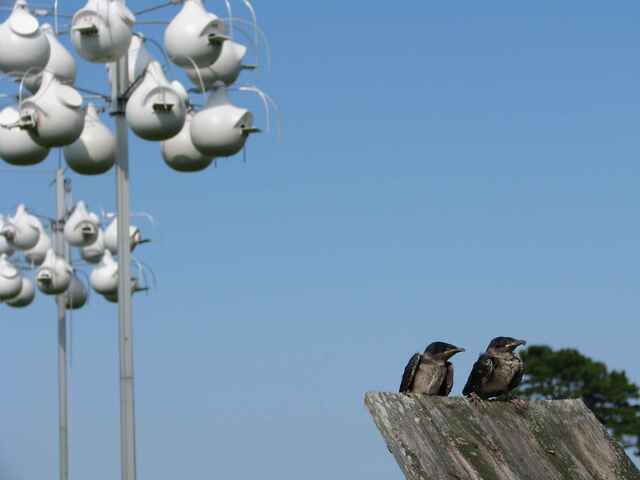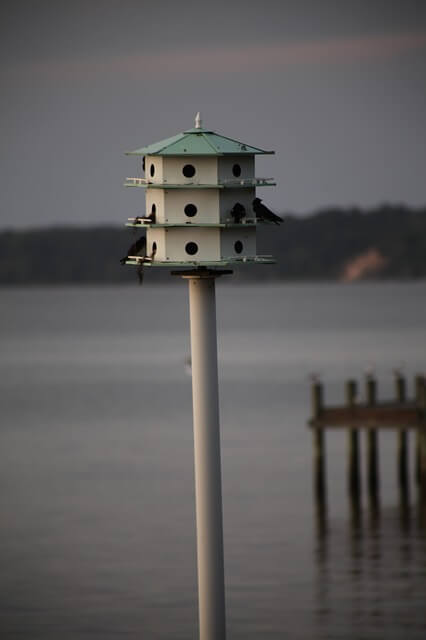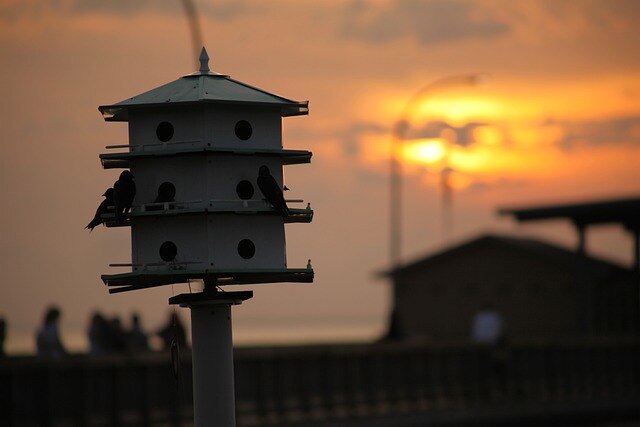
Welcome to our complete guide on attracting purple martins to your yard. These stunning birds, renowned for their vibrant purple feathers and delightful chirping, can find sanctuary in your backyard with the right setup.
In this guide, we’ll walk you through all the essentials for attracting purple martins, from creating the perfect habitat to offering nesting materials and selecting suitable housing. Additionally, we’ll delve into their dietary needs and provide tips on house placement, maintenance, and troubleshooting common issues.
Table of Contents
- 1 Key Takeaways:
- 2 How to Attract Purple Martins to your Yard?
- 3 Understanding Purple Martins: Facts and Characteristics
- 4 Creating the Ideal Purple Martin Habitat
- 5 Selecting the Right Purple Martin House
- 6 Selecting the Right Purple Martin House
- 7 Placement and Maintenance of Purple Martin Houses
- 8 Understanding the Purple Martin Diet
- 9 Welcoming Purple Martins with Water Sources
- 10 Creating Awareness and Monitoring
- 11 Troubleshooting Common Challenges
- 12 Conclusion
- 13 FAQs: How to Attract Purple Martins to your Yard
- 13.1 What is the best way to attract purple martins to my yard?
- 13.2 What kind of habitat do purple martins prefer?
- 13.3 What nesting materials should I provide for purple martins?
- 13.4 How do I choose the right purple martin house?
- 13.5 Where should I place my purple martin house?
- 13.6 What do purple martins eat?
- 13.7 Do purple martins need access to water?
- 13.8 How can I create awareness about purple martins in my community?
- 13.9 What are common challenges when attracting purple martins?
- 13.10 How can I overcome challenges and troubleshoot issues?
- 14 Author
Key Takeaways:
- Creating an ideal habitat is crucial for attracting purple martins to your yard.
- Providing suitable nesting materials and selecting the right housing options are essential.
- Understanding the purple martin diet and providing supplemental food sources are important.
- Water sources are necessary for attracting purple martins.
- Creating awareness and monitoring your purple martin houses can help contribute to their conservation.
| Attribute | Purple Martin Description |
|---|---|
| Appearance | Iridescent blue-purple with dark brown wings and tail |
| Females and Immature Birds: Duller with some gray on the head and chest; white belly | |
| Size | Length: 7.1-8.1 in (18-20.5 cm) |
| Weight: 1.6-2.1 oz (44-61 g) | |
| Wingspan: 15.0-16.5 in (38-42 cm) | |
| Range | North and South America |
| Habitat | Open habitats near water sources like lakes, rivers, and coastlines |
| Diet | Aquatic insects |
| Nesting | Under bridges or overhangs that offer shelter from predators and rain protection for their mud-made nests made out of hair collected from cows or horses |
How to Attract Purple Martins to your Yard?
To attract Purple Martins to your yard, you’ll need to provide them with suitable housing. They prefer multi-compartment birdhouses that are mounted on tall poles, at least 10–15 feet high. The birdhouse should be placed in an open area, away from trees and other obstacles.
Additionally, Purple Martins feed on insects, so it’s important to have a source of water nearby to attract insects. Finally, be patient, as it may take some time for the birds to discover and nest in your birdhouse.
Understanding Purple Martins: Facts and Characteristics
Purple martins, adorned in breathtaking purple-blue plumage and renowned for their melodious songs, captivate birdwatchers and nature enthusiasts alike. These migratory marvels grace North America with their presence during summers before embarking on an awe-inspiring journey to South America for the winter.
Did you know that purple martins hold the title of being the largest swallow species in North America? Moreover, their unique dependence on man-made nesting structures sets them apart, making them an ideal avian attraction for your yard.
Understanding the characteristics and behaviors of purple martins is key to attracting them. They favor open areas with unobstructed flight paths, so clearing obstacles and providing ample perching spots can enhance your yard’s allure. Keep your ears tuned as well; the cheerful melodies of their chirps often precede their sightings.
Offering suitable housing and nesting materials is essential for drawing purple martins to your yard. Stay tuned for our expert guide on creating the perfect habitat, selecting appropriate housing, and fulfilling their dietary needs. With these insights, you’ll be poised to welcome these vibrant and charismatic birds to your outdoor sanctuary.

Creating the Ideal Purple Martin Habitat
The first step in attracting purple martins to your yard is to create an ideal habitat for them. Purple martins prefer open areas with clear flight paths, so it’s important to consider the following when setting up their habitat:
| Factors to Consider: | Actions to Take: |
|---|---|
| Lighting | Ensure that the habitat is well-lit, providing a clear view for purple martins to fly and move around. |
| Obstructions | Minimize obstructions such as trees or buildings, which can hinder the flight path of purple martins. |
| Perching Areas | Provide perching areas, such as tall poles or high tree branches, to encourage purple martins to land and rest. |
Plant Trees & Shrubs
Purple martins are a migratory bird that is often seen in the summer around houses and other buildings. They use trees and shrubs to perch, build nests, or feed on insects attracted by these plants. The following list includes some of the more popular tree and shrub species that attract purple martins:
| Trees | Shrubs |
|---|---|
| Cedar elm | Sumac |
| Catalpa | Russian olive |
| American holly | Japanese honeysuckle |
| Tulip Poplar | Lilac |
| Kentucky Coffee Tree | Service berry |
| Norway Spruce | Elderberry |
| Chokecherry | Dogwood |
| Black cherry | Black locust |
Plant Flowers
For those seeking to entice purple martins to their yards, certain flowers serve as irresistible invitations. Purple martins adore these blossoms, returning year after year for their nectar and beauty.
| Flowers | Flowers |
|---|---|
| Roses | Calendula |
| Carnations | Verbena |
| Pansies | Marigolds |
| Foxglove | Zinnias |
| Tulips | Asters |
| Petunias | Coreopsis |
| Hollyhocks | Cosmos |
By optimizing your yard to meet their needs, you’ll increase your chances of attracting purple martins.
Selecting the Right Purple Martin House
When it comes to selecting the right purple martin house, there are a few important considerations to keep in mind. Purple martins require specific types of housing structures to nest in, and the right house can make all the difference in attracting them to your yard.
One popular option for purple martin houses is gourds. These are natural housing structures that are hung up on poles. Gourds provide an organic and aesthetic look to your backyard, while also serving as ideal nesting sites for purple martins.
Another option is a traditional purple martin house, which is typically made of wood or metal, like this one available on Amazon. These are often multi-level and have several compartments, each of which can be used for nesting. The size of the house is important to consider, as it needs to be large enough to accommodate several pairs of purple martins.
When choosing a house for your purple martins, it is important to consider the material. Wood is a natural and durable option, but it requires regular maintenance. Metal is also a good choice, as it is durable and requires minimal maintenance. Plastic houses are lightweight and easy to clean, but they may not be as durable as other options.
Before making a purchase, be sure to do your research and choose a house that is appropriate for your needs and budget. Whether you opt for a gourd, a traditional house, or another type of housing structure, the right choice can make all the difference in attracting purple martins to your yard.
Providing Nesting Materials for Purple Martins
Once you have chosen the right housing structure, it is important to provide the appropriate nesting materials for your purple martins. Purple martins are cavity-nesting birds and require suitable materials to build their nests.
There are several options for nesting materials, including pine straw, feathers, and leaves. These materials should be provided in a central location near the housing structure, so the birds can easily access them.
It is important to note that purple martins may need several different types of materials to build their nests. They may prefer specific types of materials depending on the time of year, so it is important to provide a variety of options.
By providing the right nesting materials, you can encourage purple martins to choose your yard as their nesting site. With the right housing structure and nesting materials, you’ll be well on your way to attracting these beautiful birds to your backyard.
Selecting the Right Purple Martin House
Purple martins require man-made housing structures to nest, and there are several options available, including gourds, houses, and poles. Whichever option you choose, it’s important to ensure that it meets the size requirements for purple martins, and that it is designed to be easily accessible for maintenance.
One popular option is the purple martin gourd. These small, hollow gourds can be hung from your porch or on a specialized purple martin pole, and they provide a cozy space for nesting. Another option is the purple martin house, which can be mounted on a pole or hung from a tree. These houses come in a range of designs, from simple to elaborate, and provide ample space for nesting.
| Housing Options | Description |
|---|---|
| Purple Martin Gourd | Small, hollow gourds that can be hung from a porch or pole, providing a cozy space for nesting |
| Purple Martin House | Houses that can be mounted on a pole or hung from a tree, available in a range of designs from simple to elaborate, providing ample space for nesting |
| Purple Martin Pole | A pole that is tall enough to keep the house or gourd out of reach of predators, yet short enough to be easily maintained. A good rule of thumb is to choose a metal or 4×4 wood pole that is between 12 and 15 feet tall. |
If you opt for a purple martin pole, it’s important to choose one that is tall enough to keep the house or gourd out of reach of predators, yet short enough to be easily maintained. A good rule of thumb is to choose a metal or 4×4 wood pole that is between 12 and 15 feet tall.
Ultimately, the most important factor in choosing the right purple martin housing is to ensure that it meets the specific needs of these beautiful birds. By providing a safe and comfortable nesting space, you’ll be well on your way to attracting purple martins to your yard.
Placement and Maintenance of Purple Martin Houses
Once you have selected the right housing for purple martins, proper placement and maintenance are critical for attracting and keeping these birds in your yard. Here are some guidelines to consider:
Where to Position Your Martin House
Purple martins prefer open areas with clear flight paths, so avoid placing your martin house in cluttered, wooded areas. Instead, choose an open spot with good visibility.
Mounting your house on a pole is the most effective way to attract purple martins. The pole should be at least 12-15 feet tall and positioned in an area that is clear of obstructions for a distance of at least 40 feet. Clearing away any surrounding vegetation can also help prevent predators from accessing the house.
Maintenance Tips
Checking your martin house regularly is key to preventing any damage or wear and tear. Here are some maintenance tips:
- Check for any damage or leaks in the house or its components, such as the roof, ventilation holes, or perches.
- Clean the house periodically, especially after each nesting season. This will prevent the buildup of debris or parasites that could harm the birds.
- Repair or replace any damaged or broken parts, such as doors or perches.
- Consider adding predator guards, such as metal cones, to the pole to prevent access by snakes or other animals.
By following these placement and maintenance tips, you can help ensure that your purple martin house is inviting and well-maintained, increasing your chances of attracting and keeping these beautiful birds in your yard.
Understanding the Purple Martin Diet
Knowing what purple martins eat is vital to attract them to your yard. These beautiful birds feed primarily on flying insects, such as beetles, flies, and mosquitoes. They catch their prey while flying and can consume up to their body weight in insects each day.
Providing supplemental food sources can help attract more purple martins to your yard, especially when insect populations are low. Mealworms and crickets are excellent options, but be sure to offer these sparingly, as they should not be the main staple of their diet.
I always find the easiest way to get them to your backyard, is to use a squirrel-proof suet feeder with insect suet cakes.
You can also attract insects that purple martins love by creating a bug-friendly habitat in your yard. Planting flowers and herbs such as dill, fennel, and marigolds can attract insects and create a delightful environment for these birds to feed.
It’s crucial to avoid using pesticides in your yard, as these can harm not only the insects but also the birds that depend on them for food. By catering to their dietary preferences, you’ll make your yard even more appealing to these beautiful birds.
Welcoming Purple Martins with Water Sources
Water sources are essential for attracting purple martins. These birds need to drink and bathe on a regular basis, especially during the hot summer months. By providing suitable water sources, you can make your yard even more appealing to purple martins and other bird species.
There are various options for creating water features in your yard. Birdbaths are a popular choice, as they provide a shallow pool of water that birds can use for drinking and bathing. You can also place shallow dishes of water around your yard, or install misters that create a fine mist of water for birds to enjoy.
One birdbath that I would highly recommend is the Vivosun Birdbath. I found it for a decent price on Amazon.
When choosing a water source, it’s important to consider safety and accessibility. Make sure that the water isn’t too deep, as this can be a hazard for small birds like purple martins. Additionally, be sure to place the water source in an open area with clear flight paths, so that birds can access it easily and safely.
Regular maintenance is also crucial for keeping your water sources attractive to birds. Be sure to clean and refill your birdbaths and dishes regularly, as dirty water can harbor bacteria and other harmful substances. If you have a mister, check it regularly to ensure that it’s functioning properly and providing a fine mist of water for birds to enjoy.
Overall, incorporating water sources into your yard can be an effective way to attract purple martins and other bird species. By providing a safe and accessible water source, you’ll make your yard more appealing to these birds and create a welcoming environment for them to visit and nest.

Creating Awareness and Monitoring
Attracting purple martins to your yard not only enhances your backyard environment but also contributes to their conservation efforts. Creating awareness about these beautiful birds in your community can help attract more martins to your yard. You can organize informative events, provide educational materials, or invite community members to observe martins in your yard. Engaging your community in the conservation efforts surrounding these birds is essential to their survival.
It’s also vital to monitor your martin houses regularly and know what to look for. Observe the activity around the house and check for signs of nesting, such as the presence of nesting materials or eggs. Understanding the nesting habits of purple martins can help you identify when they are building their nests and when they have abandoned them. Keeping an eye on the nesting activity can also help you identify any issues that need to be addressed, such as predation or competition from other bird species.
By being proactive and monitoring the activity around your martin houses, you can contribute to the well-being of these birds. Maintaining a welcoming and safe environment for purple martins not only increases your chances of attracting them but also promotes their conservation. Spread the word, get involved in community conservation efforts, and monitor your martin houses to ensure that these beautiful birds thrive in your backyard.
Troubleshooting Common Challenges
Attracting purple martins to your yard can be a challenging task, and there are several obstacles that you may encounter along the way. Here are some common challenges that you may face and practical solutions to overcome them.
Competition from other bird species
Purple martins often face stiff competition from other bird species for nesting sites and food sources. If you notice other birds trying to take over your martin houses or feeders, don’t despair. Here are some steps you can take to discourage other species:
| Solution | Description |
|---|---|
| Install predator guards | Adding predator guards to your martin houses or poles can help deter other birds, squirrels, and predators. |
| Offer alternative housing or food | Providing separate housing or feeders for other bird species can help reduce competition and keep your martins happy. |
| Use decoys | Setting up decoys of predators or other birds can help deter unwanted species from your yard. |
Nest predation
Purple martin nests can be vulnerable to predators like snakes, raccoons, and squirrels. Here are some measures you can take to protect your martin nests:
| Solution | Description |
|---|---|
| Install predator guards | Adding predator guards to your martin houses or poles can help prevent predators from accessing the nests. |
| Use nest trays | Providing nest trays inside your martin houses can help protect the eggs and nestlings from predators. |
| Monitor regularly | Regularly checking your martin houses and nests can help you detect signs of predation and take appropriate action. |
Deterrents
Some homeowners may encounter resistance from neighbors or homeowner associations when it comes to attracting purple martins. Concerns about noise, mess, and property damage can be valid, but there are ways to address these issues. Here are some tips for dealing with deterrents:
| Solution | Description |
|---|---|
| Educate others | Spread awareness about the benefits of attracting purple martins, such as their role in controlling insect populations. |
| Keep your property clean | Regularly cleaning your martin houses or feeders can help reduce mess and odor. |
| Use noise-reducing measures | Adding sound baffles or selecting quieter housing options can help minimize noise levels. |
By implementing these solutions, you can overcome common challenges and successfully attract purple martins to your yard. Along the way, don’t forget to enjoy the beauty and grace of these amazing birds!
Conclusion
Attracting purple martins to your yard requires patience, persistence, and attention to detail. By understanding their habits and preferences and providing the right habitat, housing, food, and water, you can create an inviting environment that will attract these beautiful birds.
Remember to monitor your martin houses and maintain them regularly, while also being aware of potential challenges and taking proactive steps to overcome them.
Take Action Today
Start implementing the strategies outlined in this guide and enjoy the beauty and grace of purple martins in your own backyard. Together, we can contribute to the conservation of these incredible birds and promote their well-being in our communities.
FAQs: How to Attract Purple Martins to your Yard
What is the best way to attract purple martins to my yard?
To attract purple martins to your yard, you should create an ideal habitat, provide nesting materials, choose the right housing, offer the proper diet, and have water sources available.
What kind of habitat do purple martins prefer?
Purple martins prefer open areas with clear flight paths. Ensure proper lighting, minimize obstructions, and create perching areas to optimize your yard for purple martin habitation.
What nesting materials should I provide for purple martins?
Purple martins are cavity-nesting birds. Provide materials such as pine straw, feathers, and leaves to assist them in building their nests.
How do I choose the right purple martin house?
Consider factors like size, design, and accessibility when selecting a purple martin house. Options include martin houses, gourds, or poles.
Where should I place my purple martin house?
Proper placement is essential. Position your martin house at the right height on a pole to attract purple martins. Regular maintenance is also important.
What do purple martins eat?
Purple martins primarily eat flying insects. Providing supplemental food sources and attracting insects they love will help make your yard more appealing to them.
Do purple martins need access to water?
Yes, purple martins need water for drinking and bathing. Consider providing water sources such as birdbaths, shallow dishes, or misters to attract them.
How can I create awareness about purple martins in my community?
Spread the word, organize educational events, and involve your community in purple martin conservation efforts to attract more of these birds.
What are common challenges when attracting purple martins?
Challenges may include competition from other bird species, nest predation, and deterrents. Practical solutions exist for these challenges.
How can I overcome challenges and troubleshoot issues?
By following the steps in this guide, you’ll have the knowledge to overcome challenges and troubleshoot issues when attracting and hosting purple martins.






